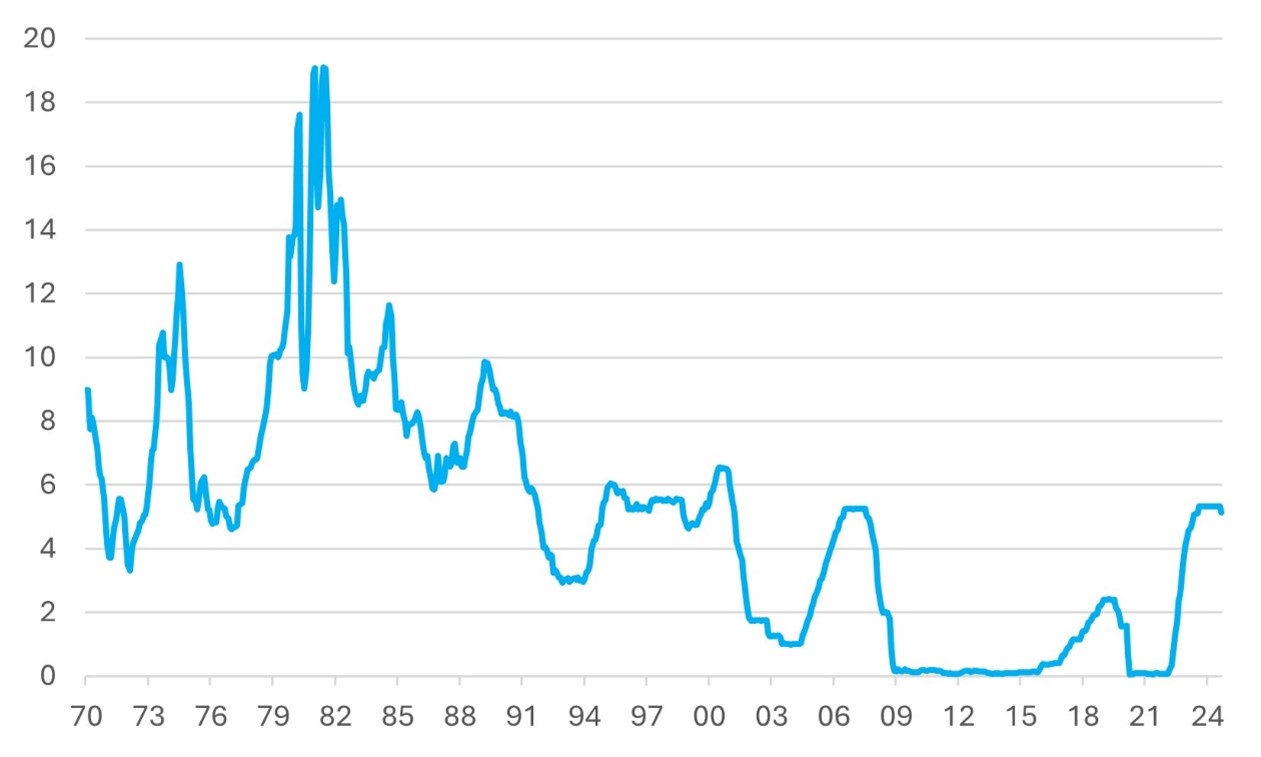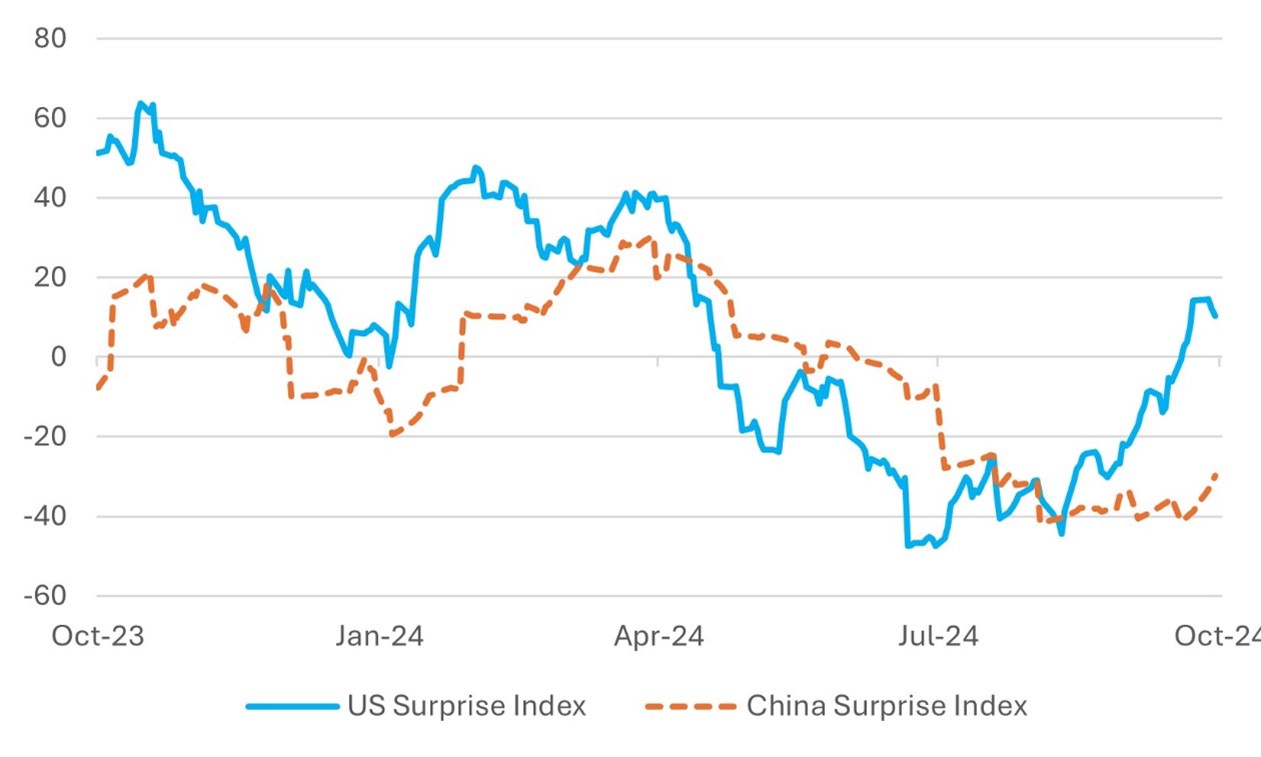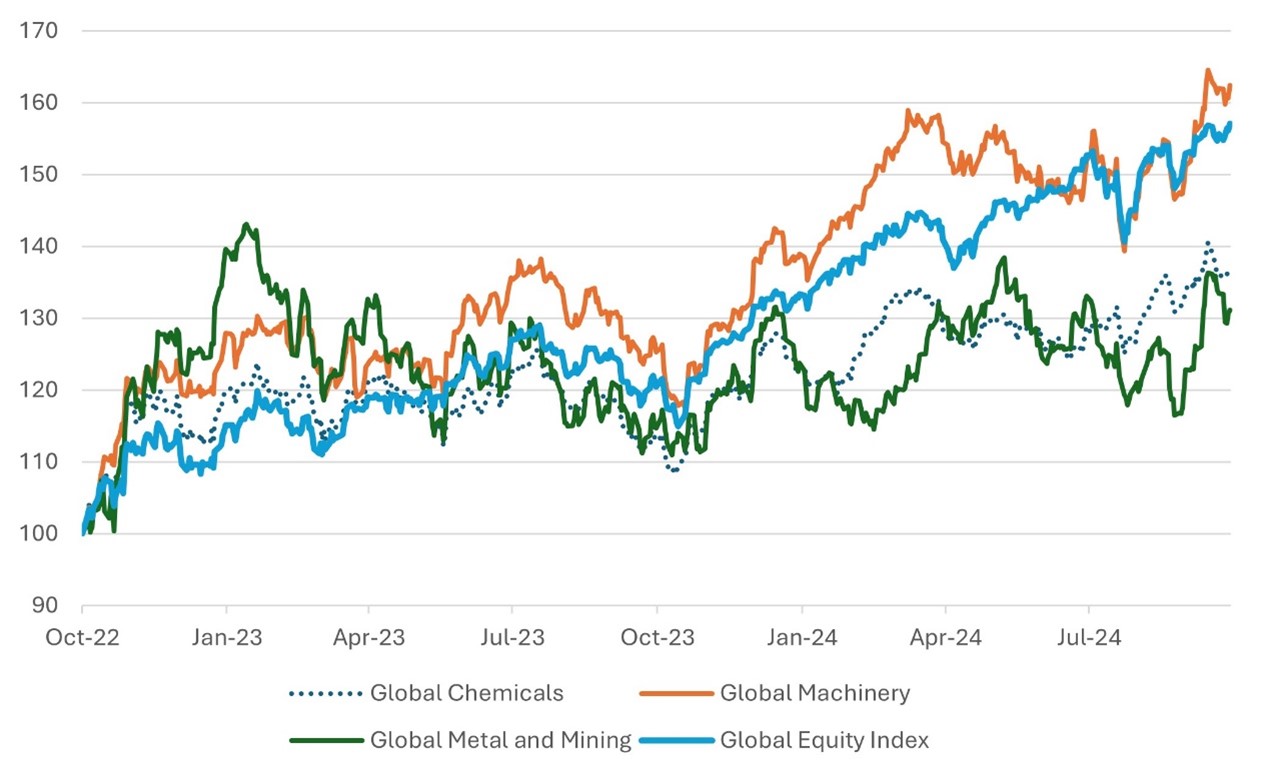By Falco
14 Oct 2024
• The urgency for US Fed fund rate cuts dissipates.
• US growth and inflation data continue to surprise to the upside modestly.
• The Chinese authorities tell a good story about providing support for their economy.
• Should China follow through on its reflation initiatives, we expect global stock market leadership to shift to the cyclicals
• There is room for outperformance from developed market cyclicals and consumer stocks linked to China.
• Europe can only hope for an acceleration of rate cuts in the absence of looser fiscal policy. The ECB will deliver 25bps this week.
The dialogue in the markets has made a subtle shift in the last few weeks. It’s no longer about the urgent need for large rate cuts and more about the building confidence in a possible acceleration of global growth - a reflation.
Recent US employment and inflation reports have cast doubt on market expectations that the Federal Reserve will implement steady rate cuts of 25bps per meeting over the next 12 months. There are even mutterings among bond strategists that the Fed might even pause the rate cuts altogether given the stronger-than-anticipated employment figures and inflation data. Asset manager PIMCO, recently advised that we should be prepared for a range of potential possibilities on rate cuts including the chances of a Fed pause. Barely two weeks ago major research houses were suggesting that the next cut would be of 50bps, similar to the mid-September move from the Fed that saw it trim rates by half a percentage point.
Recent history has shown that the Fed can shift its view of the path that the rate cuts take based on evolving economic conditions. A pause in the easing cycle would likely occur when the Fed seeks more clarity on the economic trajectory. As investors, avoid committing too heavily to any single outcome. Instead, portfolio positioning should reflect the range of potential scenarios, rather than a firm expectation of any particular Fed action at upcoming meetings. The Fed's confidence in the pace of rate cuts over the next year remains uncertain, and our investment strategies should account for this ambiguity.
Here is a list of our conviction calls about the future path of interest rates:
1. The Fed funds should fall as real rates are high by historic standards
2. The US economy is not as weak as many had expected and hence the urgency for rate cuts has abated.
3. Who wins the November presidential election is important to forecasting the path of interest rates in the coming year. More government spending, fewer rate cuts.
In an article published by “Tufts Now” last week economist
4. In the absence of a crisis, it is not likely that the Fed Funds rate will fall in a straight line. Investors have almost got used to rates rising or falling in a nearly straight line. However, if we look back in (distant) history we find that the Fed often pauses rates for a meeting or two to reassess monetary policy. The last few decades have been different as these were largely periods of crisis management when rates had to be raised rapidly or cut substantially in a very short order of time. The 1970s, 80s, and 90s were times when changes in monetary policy were not very uniform.
Chart 1: US Fed Funds Rate Only Falls Rapidly During a Crisis
(%)
Source: Bloomberg
With the headline and Core CPI being ahead of expectations, the US inflation report marginally disappointed the market. Headline and core inflation was a tenth higher than market expectations. The tick-up in core inflation to 3.3% caught the market's eye. The resulting market disappointment manifested itself in a consolidation of the bond market losses of past weeks.
It was almost becoming conventional of late thinking that the next phase in risk markets would be driven by a good pace of rate cuts. While rate cuts are likely to be forthcoming, the strategy of buying interest rate-sensitive sectors does not hold the potential it once did. Interest rate-sensitive sectors such as banks and REITs have struggled to perform of late. In bond markets, the more limited rate cuts have manifested themselves in sell offs but the continued outperformance of credit markets shows that investors still believe that global growth will be OK, particularly in the US.
Is it time for reflation trade?
The question remains: Is a broader reflation trade on the horizon? Recent stronger-than-expected US growth and inflation numbers, paired with China’s economic policies aimed at reigniting its economy, suggest that could be the case.
China's reflation efforts are brimming with promises, but the numbers are still lacking. Over the weekend, China’s Finance Minister, Lan Foan, outlined plans for significant bond issuance to raise funds to address the unsold large inventory of properties. While specific figures were missing, the market anticipates that these measures will meet consensus expectations for a substantial fiscal boost.
In addition, the government pledged relief for local government debt through a debt swap facility into sovereign bonds and promised capital injections to restructure the balance sheets of state-owned banks. With the government's clear focus on hitting its 5% GDP growth target for the year, investors are hopeful that these measures will be implemented sooner rather than later.
Chart 2: US and China Economic Surprise Indices May be on the Cusp of Rising/Reflating
Source: Bloomberg
Sectors that benefit from reflation rather than falling interest rates could lead the next leg up in the global equity markets. Chemicals, metals and mining, and technology could therefore be the next leaders. Consumer stocks directly linked to stronger Chinese consumer demand may also benefit.
Chart 3: Most Cyclical Sectors Have Struggled to Match the Market Performance
Source: Bloomberg
Europe appears to be the last major region to join the reflation trend. As the European Central Bank meets this week, we anticipate a 25-bp rate cut, despite some hesitation among the voting members. With limited prospects for increased government spending, monetary policy remains the primary lever to stimulate economic growth. A stronger Chinese economy should boost Eurozone exports, especially in cyclical sectors. Given this, investors might find better opportunities in Europe by focusing on sector-specific funds rather than broad-based index investments.
Gary Dugan - Investment Committee Member
Bill O'Neill - Non-Executive Director & Investor Committee Chairman
14th October 2024
The information contained within is for educational and informational purposes ONLY. It is not intended nor should it be considered an invitation or inducement to buy or sell a security or securities noted within nor should it be viewed as a communication intended to persuade or incite you to buy or sell security or securities noted within. Any commentary provided is the opinion of the author and should not be considered a personalised recommendation. The information contained within should not be a person's sole basis for making an investment decision. Please contact your financial professional at Falco Private Wealth before making an investment decision. Falco Private Wealth are Authorised and Regulated by the Financial Conduct Authority. Registered in England: 11073543 at Millhouse, 32-38 East Street, Rochford, Essex SS4 1DB
